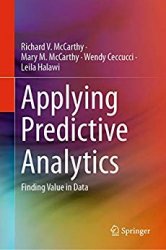Applying Predictive Analytics: Finding Value in Data
- Добавил: literator
- Дата: 25-06-2019, 14:17
- Комментариев: 0
 Название: Applying Predictive Analytics: Finding Value in Data
Название: Applying Predictive Analytics: Finding Value in Data Автор: Richard V. McCarthy, Mary M. McCarthy
Издательство: Springer
ISBN: 3030140377
Год: 2019
Страниц: 209
Язык: английский
Формат: pdf (true), epub
Размер: 14.3 MB
This textbook presents a practical approach to predictive analytics for classroom learning. It focuses on using analytics to solve business problems and compares several different modeling techniques, all explained from examples using the SAS Enterprise Miner software. The authors demystify complex algorithms to show how they can be utilized and explained within the context of enhancing business opportunities. Each chapter includes an opening vignette that provides real-life example of how business analytics have been used in various aspects of organizations to solve issue or improve their results. A running case provides an example of a how to build and analyze a complex analytics model and utilize it to predict future outcomes.
Machine learning, a branch of artificial intelligence, uses computation algorithms to automatically learn insights from the data and make better decisions in the future with minimal intervention. Regression techniques may also be in machine learning techniques, e.g., neural networks. An artificial neural network (ANN) or neural network is a system, including algorithms and hardware, that strive to imitate the activity of neurons in the brain. A key element of the neural network is the ability to learn from the data. The neural network is composed of multiple nodes and is typically organized in layers. The layers are comprised of interconnected nodes. The nodes can take input data and perform algorithms on the data and then pass the results (activation or node value) to intermediary or hidden layers. The hidden layers then link to an output layer reflecting the results. Chapter 6 will examine neural networks.
Decision trees are very popular in predictive modeling for several reasons—they are easy to understand, easy to build, can handle both nominal and continuous variables, can handle missing data automatically, and can handle a wide variety of data sets without applying transformations to the input. Decision trees are comprised of nodes and branches. The nodes contain questions (premises), and the response to the questions determines the path to the next node (conclusion). Branches link the nodes reflecting the path along the decision tree. The initial question on the decision tree is referred to as the root node. Chapter 5 will examine decision tree models in detail.
Applying predictive analytics to Big Data enables organizations to make better and faster decisions. Predictive analytics can help organizations mitigate their risk, maximize their profits, optimize their operations, and gain a competitive advantage.
Скачать Applying Predictive Analytics: Finding Value in Data
[related-news] [/related-news]
Внимание
Уважаемый посетитель, Вы зашли на сайт как незарегистрированный пользователь.
Мы рекомендуем Вам зарегистрироваться либо войти на сайт под своим именем.
Уважаемый посетитель, Вы зашли на сайт как незарегистрированный пользователь.
Мы рекомендуем Вам зарегистрироваться либо войти на сайт под своим именем.
